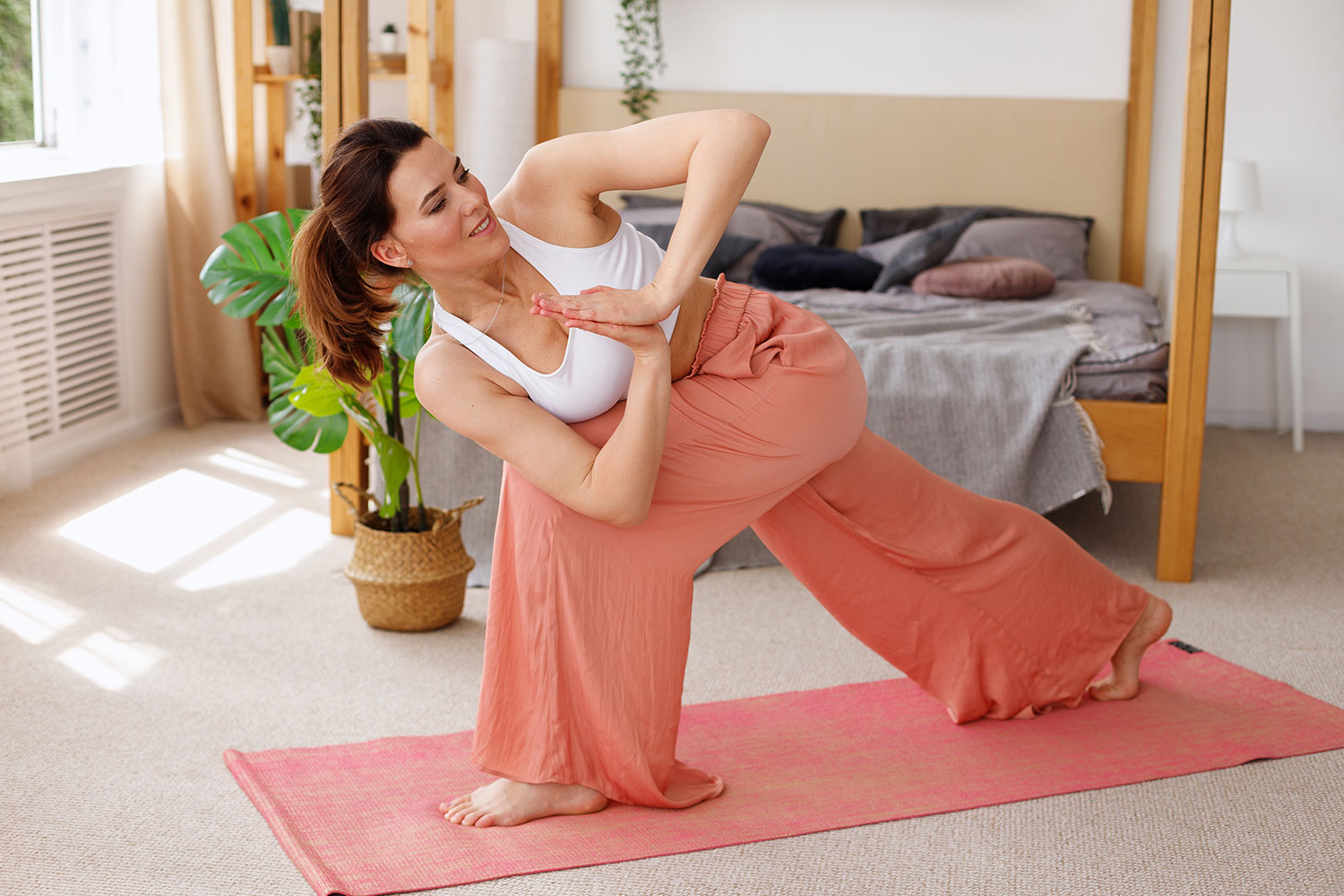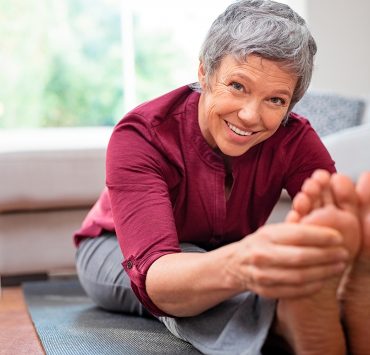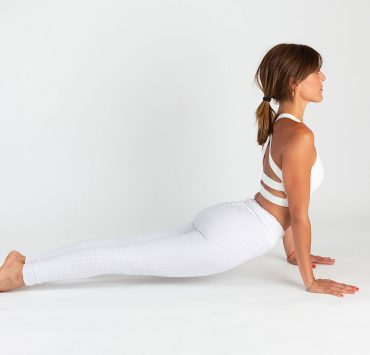
After spending nearly two decades as a relationship therapist, Patricia…
A consistent morning yoga practice is something everyone can benefit from, and don’t worry, ‘morning’ doesn’t necessarily mean 6 AM. It technically doesn’t even have to be before noon; it all depends on what time your day typically starts.
I’ll admit – Mornings aren’t really my thing. It takes a pretty good reason (and a lot of coercing) to get me out of bed early. Yoga supplies just the right amount of energy exertion that my body can handle first thing. Plus, it makes me feel good for the entire day, which is reason enough to roll out my mat and strike a downward dog or two.
Believe me, once you get into it, you won’t be able to stop. Still need a little convincing? Read all the benefits below then try the 30-minute practice tomorrow morning – I promise you won’t be disappointed.
Why Should I Do Yoga In The Morning?

Yoga boosts energy levels so you can skip the extra cup of coffee!
You’ll feel more focused throughout the day.
You’re less likely to feel achy or get injured during the day.
Yoga stimulates your metabolism, so eat up!
You’ll notice a decrease in stress and tension.
Your body will feel more toned and fit over time.
Morning practice establishes a healthy sleep rhythm and routine.
Take your time with this sequence and move mindfully through each shape. In the standing postures, feel free to take a vinyasa between poses or when switching sides. Remember that Child’s Pose is always available when you need to take a moment and collect your breath. Meet your body where it’s at in this moment, using props for extra support and showing yourself compassion by not forcing or rushing the process.
Warmup
Neck and Shoulder Stretches

Find a comfortable seat with hips elevated on a blanket or block.
Slowly drop your left ear to your left shoulder and gently roll the head to the other side in a clockwise direction.
Make three full circles before switching directions.
Bring your fingertips to rest on your shoulders.
Make circles with the elbows, going clockwise three times and counterclockwise three times.
Marjaryasana — Cat-Cow Pose

Start on all fours with knees under hips and palms under shoulders.
Spread the fingers wide.
Inhale to drop your belly while lifting your gaze and tailbone toward the ceiling.
Exhale to round the spine while tucking your chin and tailbone.
Flow through this movement 3 to 5 more times.
Parsva Balasana — Thread the Needle Pose

Find your way to a tabletop position.
Slide your left hand under your right arm with palm facing up.
Place your left cheek down to the mat or a block.
With each exhale, soften the left shoulder.
Hold for 30 seconds on each side.
Chaturanga Dandasana — Bird Dog Pose

Start on all fours with wrists stacked under shoulders and knees under hips.
As you inhale, reach your left arm forward and right leg backward.
Make a line of energy from the front hand to the back foot.
Keep the spine straight and the neck long.
Hold for 15-30 seconds on each side.
Uttana Shishosana — Extended Puppy Pose

Start in a tabletop position with hips directly over knees and toes tucked.
Slowly walk the hands forward and begin to melt the heart towards the floor.
Let the forehead rest on either the floor or a block.
Try to keep the hips stacked over the ankles.
Hold for 30 seconds to a minute.
Standing Sequence
Pada Hasthasana – Standing Forward Bend Pose

From a standing position, hinge at the hips and let the arms go heavy towards the floor.
Lengthen the torso away from the pelvis as you move deeper into the fold.
Place fingertips or palms on the floor, on blocks, or grab for opposite elbows.
Maintain a gentle bend in the knees.
Engage the legs by drawing the kneecaps up to loosen the lower back.
Move your weight towards the toes to arrange the hips over the ankles.
Allow the head and neck to hang heavily.
Hold for 30 seconds to a minute.
Anjaneyasana — Low Lunge Pose

Starting in Downward Facing Dog Pose, step your left foot between your hands.
Drop your right knee to the ground and untuck the toes.
Inhale your arms up to your left thigh or raise them overhead.
Settle the pelvis down and forward as you lift from the waist.
Breathe here for 30 seconds before switching sides.
Utkatasana — Chair Pose

Start standing at the head of your mat with big toes together and roughly an inch between the heels.
As you inhale, sink low in the hips and raise the arm bones by your ears.
Turn your palms to face each other and sink back into the heels.
Fire up the core by pulling the navel toward the spine.
Hold for 30 seconds or longer.
Garudasana — Eagle Pose

Start standing at the head of your mat with feet together and a slight bend in the knees.
On an inhale, lift your right leg and cross the right thigh over your left thigh.
Kickstand your right foot or continue to wrap the foot around your left calf for a full bind.
Wrap the right arm under the left, crossing at the elbows.
Bring the palms together for a full bind or let the backs of the hands meet.
Move the elbows up and away from the body.
Breathe space into the upper back.
Hold for 3-5 full breaths on each side.
Virabhadrasana II — Warrior II Pose

Start at the front of your mat with feet together.
Take a wide step back with your left foot.
Turn your left foot out and right toes straight ahead.
Line the front heel with the back arch.
Inhale your arms out in a T-shape and gaze out beyond your right hand.
Exhale as you bend deeply into the front knee, stacking it directly over the ankle.
Keep your spine straight up from the pelvis.
Take 5 deep breaths on both sides.
Cool Down
Paschimottanasana — Seated Forward Fold Pose

Find a comfortable seat with legs extended in front.
Remove any extra flesh from the sit bones and ground down through your base.
Lengthen your spine, so it’s perpendicular to the floor.
As you inhale, draw the navel in towards the spine while raising the arms overhead.
As you exhale, drape the upper body over the legs.
Activate the legs by drawing the kneecaps towards the thighs.
Reach your peace fingers towards your big toes or let the hands rest on the floor.
Release any tension in the head and neck, using blocks or a bolster as needed.
Stay here for 30 seconds or longer before slowly rising back up with a straight spine.
Ardha Matsyendrasana — Seated Twist Pose

Find a comfortable seat with both legs straight in front of you and sit bones grounded down.
Keep your right leg straight as you bend the left knee in towards the chest.
Plant your left foot flat, moving the heel towards the sit bones.
Place your left arm on the floor or a block behind your hips for support.
Inhale the right arm straight up and exhale to hook or hug the elbow around the left knee.
Breathe deep into the lower belly, following the twist up the spine on your inhale.
Exhale to twist a little deeper, taking your gaze over the left shoulder if it feels okay on the neck.
Stay for 3-5 rounds of breath before moving to the other side.
Viparita Karani — Waterfall Pose

Make your way to your back with knees bent and feet flat at hip-width.
Inhale to press into the feet and lift the hips.
Place a block under your sacrum and lower the pelvis to rest on the block.
Keeping the block under your sacrum, slowly bring one knee at a time toward your chest.
Lengthen both legs straight up towards the ceiling.
Stay here for 1 to 3 minutes before slowly bending both knees back towards the chest.
Supta Matsyendrasana — Reclined Spinal Twist Pose

Start on your back with knees bent and feet planted at hip-width.
Inhale to cross your left ankle above your right knee.
Flex your left foot and let the knee drop open.
If this feels like a good enough stretch, stay here.
Otherwise, reach up and clasp your hands around the right thigh or shin and hug the leg towards your chest.
Find stillness or take some gentle rocking motions side to side.
Hold for about a minute on each side.
Supta Baddha Konasana — Reclined Bound Angle Pose

Starting on your back, draw the soles of the feet together and let the knees relax out wide.
Place blocks or blankets under the thighs as needed.
Place one hand on your belly and the other on your heart and begin to notice the natural rhythm of your breath.
Allow the eyes to settle back into the head, and the muscles of the face, neck, and jaw to soften.
Stay here for as long as you need, using the stillness to check in and tune out.
If you’d like to move to Savasana, lengthen both legs out on the mat.
What's Your Reaction?
After spending nearly two decades as a relationship therapist, Patricia journeyed down the path of writing as a vehicle for sharing her wisdom. Her work reflects a sincere interest in readers’ wellbeing and is abundant with helpful advice and fascinating insight.














